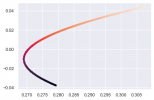- Joined
- 12/25/20
- Messages
- 13
- Points
- 11
Hi all, could you please help me identify if there is anything wrong in my code? And if nothing is wrong, could you please let me know why the graph looks weird?
[CODE lang="python" title="Efficient Frontier"]# -*- coding: utf-8 -*-
"""
Created on Wed Jan 13 17:03:13 2021
"""
import pandas as pd
import numpy as np
import matplotlib.pyplot as plt
import seaborn as sns
sns.set()
from math import *
from scipy.optimize import minimize
pd.set_option('display.max_rows', 10)
pd.set_option('display.max_columns', 10)
import pickle
from pandas_datareader import data as wb
tickers=['F','GM']
data=pd.DataFrame()
for t in tickers:
data[t]=wb.DataReader(t, data_source='yahoo', start='07-5-2012', end='5-7-2020')['Adj Close']
log_returns=np.log(data/data.shift(1))
num_ports=50000
ret_array=np.zeros(num_ports)
all_weights=np.zeros((num_ports, len(data.columns)))
vol_array=np.zeros(num_ports)
sharpe_array=np.zeros(num_ports)
for ind in range(num_ports):
weights=np.random.random(2)
weights=weights/np.sum(weights)
all_weights[ind,:]=weights
ret_array[ind]=np.sum(weights*log_returns.mean()*252)
vol_array[ind]=sqrt(np.dot(weights.T, np.dot(weights, log_returns.cov()*252)))
sharpe_array[ind]=ret_array[ind]/vol_array[ind]
plt.scatter(vol_array, ret_array, c=sharpe_array, s=8)
plt.show()
[/CODE]
[CODE lang="python" title="Efficient Frontier"]# -*- coding: utf-8 -*-
"""
Created on Wed Jan 13 17:03:13 2021
"""
import pandas as pd
import numpy as np
import matplotlib.pyplot as plt
import seaborn as sns
sns.set()
from math import *
from scipy.optimize import minimize
pd.set_option('display.max_rows', 10)
pd.set_option('display.max_columns', 10)
import pickle
from pandas_datareader import data as wb
tickers=['F','GM']
data=pd.DataFrame()
for t in tickers:
data[t]=wb.DataReader(t, data_source='yahoo', start='07-5-2012', end='5-7-2020')['Adj Close']
log_returns=np.log(data/data.shift(1))
num_ports=50000
ret_array=np.zeros(num_ports)
all_weights=np.zeros((num_ports, len(data.columns)))
vol_array=np.zeros(num_ports)
sharpe_array=np.zeros(num_ports)
for ind in range(num_ports):
weights=np.random.random(2)
weights=weights/np.sum(weights)
all_weights[ind,:]=weights
ret_array[ind]=np.sum(weights*log_returns.mean()*252)
vol_array[ind]=sqrt(np.dot(weights.T, np.dot(weights, log_returns.cov()*252)))
sharpe_array[ind]=ret_array[ind]/vol_array[ind]
plt.scatter(vol_array, ret_array, c=sharpe_array, s=8)
plt.show()
[/CODE]
